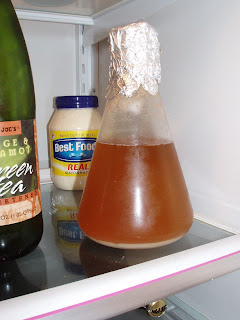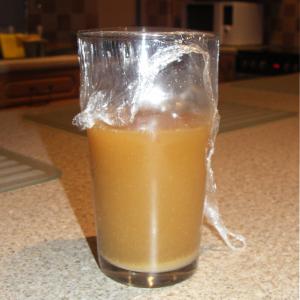I am going to do my first yeast starter tomorrow in preparation for my brew on Saturday. I just want to make sure that I have everything down.
Boil 6 cups of water in a small pot, remove from flame, stir in 1 cup of Munton & Fison Light Dry Malt Extract. When fully dissolved, move the pot back to the flame. Soak the 2000ml flask in StarSan solution during the starter wort boil. Boil starter wort for 15 min total, stirring regularly so that the DME does not scorch. During the last minute of the boil, add a 1/2 teaspoon of yeast nutrient (Diammonium Phosphate) to the pot. Cool the wort by placing it into an ice bath in kitchen sink (be sure not to get any ice water into the wort), agitate pot to cool wort faster. When wort is 75*F or below, pour starter wort into flask using a funnel. Pitch White Labs 007 English Ale yeast into flask as well as the stir bar. Then cover the flask with a piece of foil and a rubberband and place on stirplate. Turn on stirplate and wait roughly 12-18 hours. Once kraeusen has been attained, place flask in fridge for a day to allow yeast slurry to settle. On brew day, take flask out of fridge about an hour or two before you begin to make your wort. Decant any beer that formed on top of the yeast layer by carefully pouring it out of the flask. This helps ensure that there will be no off flavors from the yeast starter. Note: when pitching the yeast make sure it's within a couple degrees of the wort as to not shock the yeast.
Boil 6 cups of water in a small pot, remove from flame, stir in 1 cup of Munton & Fison Light Dry Malt Extract. When fully dissolved, move the pot back to the flame. Soak the 2000ml flask in StarSan solution during the starter wort boil. Boil starter wort for 15 min total, stirring regularly so that the DME does not scorch. During the last minute of the boil, add a 1/2 teaspoon of yeast nutrient (Diammonium Phosphate) to the pot. Cool the wort by placing it into an ice bath in kitchen sink (be sure not to get any ice water into the wort), agitate pot to cool wort faster. When wort is 75*F or below, pour starter wort into flask using a funnel. Pitch White Labs 007 English Ale yeast into flask as well as the stir bar. Then cover the flask with a piece of foil and a rubberband and place on stirplate. Turn on stirplate and wait roughly 12-18 hours. Once kraeusen has been attained, place flask in fridge for a day to allow yeast slurry to settle. On brew day, take flask out of fridge about an hour or two before you begin to make your wort. Decant any beer that formed on top of the yeast layer by carefully pouring it out of the flask. This helps ensure that there will be no off flavors from the yeast starter. Note: when pitching the yeast make sure it's within a couple degrees of the wort as to not shock the yeast.



